新版闽教版小学英语第五册教学参考书
- 格式:doc
- 大小:420.00 KB
- 文档页数:61
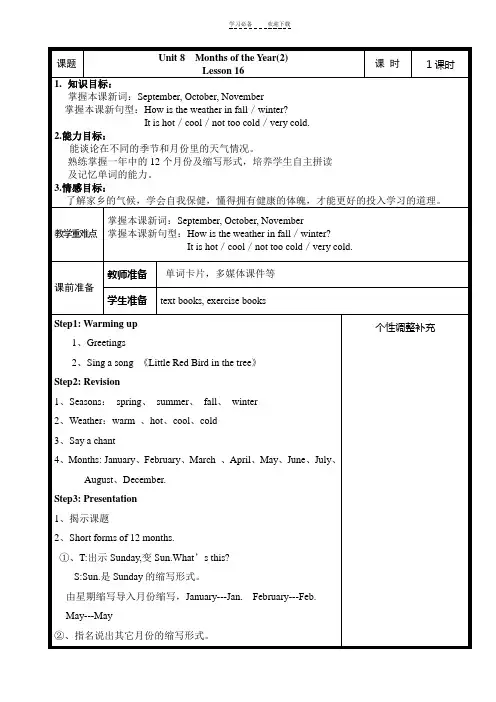
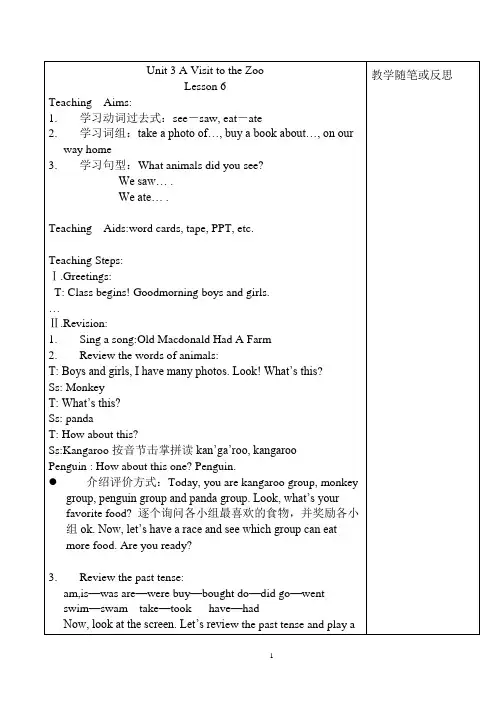
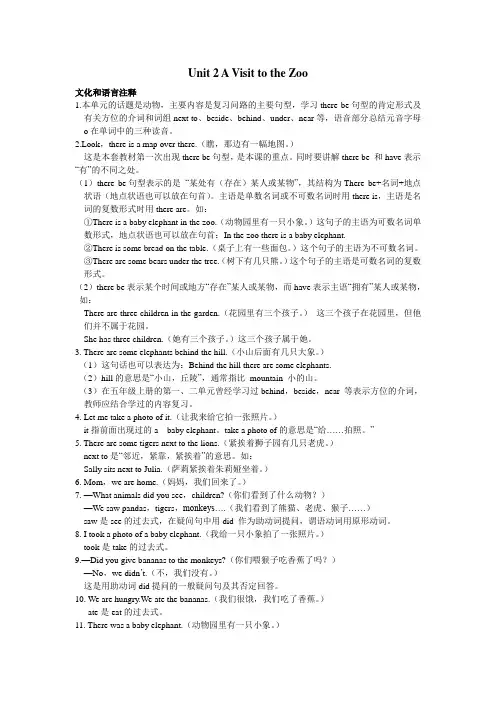
Unit 2 A Visit to the Zoo文化和语言注释1.本单元的话题是动物,主要内容是复习问路的主要句型,学习there be句型的肯定形式及有关方位的介词和词组next to、beside、behind、under、near等,语音部分总结元音字母o在单词中的三种读音。
2.Look,there is a map over there.(瞧,那边有一幅地图。
)这是本套教材第一次出现there be句型,是本课的重点。
同时要讲解there be 和have表示“有”的不同之处。
(1)there be句型表示的是“某处有(存在)某人或某物”,其结构为There be+名词+地点状语(地点状语也可以放在句首)。
主语是单数名词或不可数名词时用there is,主语是名词的复数形式时用there are。
如:①There is a baby elephant in the zoo.(动物园里有一只小象。
)这句子的主语为可数名词单数形式,地点状语也可以放在句首:In the zoo there is a baby elephant.②There is some bread on the table.(桌子上有一些面包。
)这个句子的主语为不可数名词。
③There are some bears under the tree.(树下有几只熊。
)这个句子的主语是可数名词的复数形式。
(2)there be表示某个时间或地方“存在”某人或某物,而have表示主语“拥有”某人或某物,如:There are three children in the garden.(花园里有三个孩子。
)这三个孩子在花园里,但他们并不属于花园。
She has three children.(她有三个孩子。
)这三个孩子属于她。
3. There are some elephants behind the hill.(小山后面有几只大象。
![[K12配套]小学英语精编资料闽教版小学英语第五册教案(超完整版_排版好的_可以直接打印)](https://uimg.taocdn.com/8c5e280231126edb6f1a1083.webp)
Unit 1 Getting Ready for School一、Teaching Material (教材分析)本单元主要学习一般过去时,利用简单的词汇开启学生学习动词过去式,主要句型为:Were you in the supermarket? Yes, I was. / No, I wasn’t.I bought a….Were you at home yesterday? No, I wasn’t.Where did you go? I went to the supermarket.二、Teaching Aims (教学目标)1、通过学习,能使用were / was谈论过去发生的事情。
2、在合作学习中,培养学生合作交流的能力,开启学生学习英语的兴趣。
3、通过学习,培养学生的口语交际。
三、Important&Difficult Points(教学重难点)1、理解were和was分别是are, am/is的过去式;听懂运用句型Were you…?进行问答。
2、理解一般过去式,听懂运用句型Where did you go? I went to….问答。
四、Teaching Aids(教具)录音机、挂图、卡片。
Unit 1 Getting Ready for SchoolLesson 1一、教学目标1、知识目标:(1)Were you in the supermarket? Yes, I was. / No, I wasn’t.(2)I bought a….(3)were, was, just now, bought, schoolbag, bookstore.2、能力目标:能使用were / was谈论过去发生的事情。
二、重点、难点1、理解were和was分别是are, am/is的过去式;2、听懂运用句型Were you…?进行问答。
三、资源准备Tape recorder,cards,some cards.四、教学过程Ⅰ.Warmer1.Greetings.2. Free talk.Ⅱ.Presentation:1. Show the word cards and review some words.pen, pencil, book, bag, school…2. Teac h and practice “schoolbag”(read it one by one)school+bag→schoolbag3. T: Take your schoolbags, getting ready for school. Today w e’ll learn Unit 1 Getting Ready for School Lesson 1.(Write down the title.)Ⅲ.New lesson1. T: I want to buy a new bag. Where can I go?S: Supermarket.2. I’m in the supermarket now.3. book → bookstore in the bookstoreHe / She is in the bookstore.4. now → just nowExplain it is the past time.5. Explain and practice these verbs and the past tense.am / is → was are → were buy → bought6. Change the sentences. PPT shows some places and things , ask the Ss to practice the sentences.I was in the … just now.I bought a ….7. Teach and practice “Were you in the …? Yes, I was./ No, I wasn’t.”(1)Practice the sentences in groups.(2) Ask and answer.8. Learn to say.(1) Listen and point.(2) Listen and repeat.(3) Read in roles..Ⅳ.Practice:1. Look and say.2. Work in pairs.Were you in the …? Yes, I was.3. Play a guessing game.4. Let’s chant.Ⅴ.Homework:1. Read the text.2. Copy the new words and make sentences.3. Finish Activity Book Lesson 1.Unit 1 Getting Ready for SchoolLesson 2一、教学目标1、知识目标:(1) Were you at home yesterday? No, I wasn’t.(2)Where did you go? I went to the supermarket.(3)Words: yesterday, did, went.2、能力目标:谈论过去发生的事情。
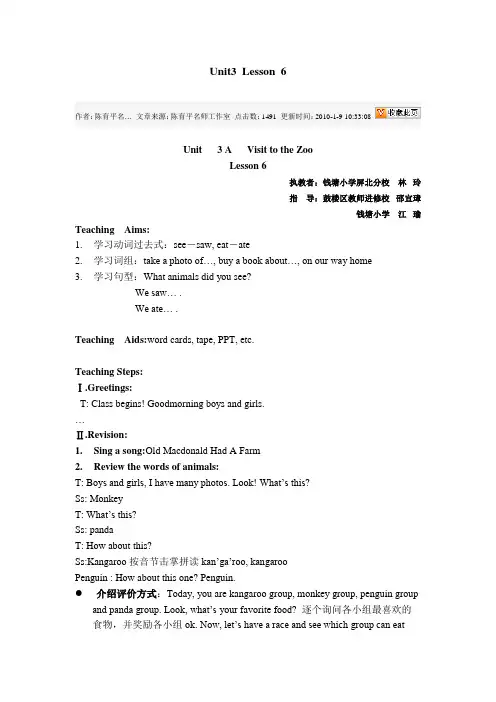
Unit3 Lesson 6作者:陈育平名…文章来源:陈育平名师工作室点击数:1491 更新时间:2010-1-9 10:33:08Unit 3 A Visit to the ZooLesson 6执教者:钱塘小学屏北分校林玲指导:鼓楼区教师进修校邵宜璋钱塘小学江瑜Teaching Aims:1.学习动词过去式:see-saw, eat-ate2.学习词组:take a photo of…, buy a book about…, on our way home3.学习句型:What animals did you see?We saw… .We ate… .Teaching Aids:word cards, tape, PPT, etc.Teaching Steps:Ⅰ.Greetings:T: Class begins! Goodmorning boys and girls.…Ⅱ.Revision:1.Sing a song:Old Macdonald Had A Farm2.Review the words of animals:T: Boys and girls, I have many photos. Look! What’s this?Ss: MonkeyT: What’s this?Ss: pandaT: How about this?Ss:Kangaroo按音节击掌拼读kan’ga’roo, kangarooPenguin : How about this one? Penguin.介绍评价方式:Today, you are kangaroo group, monkey group, penguin group and panda group. Look, what’s your favorite food? 逐个询问各小组最喜欢的食物,并奖励各小组ok. Now, let’s have a race and see which group can eatmore food. Are you ready?3.Review the past tense:am,is—was are—were buy—bought do—did go—went swim—swamtake—took have—hadNow, look at the s creen. Let’s review the past tense and play a game: 连环炮T: Did you have a good time? Now let’s say a chant.播放PPTChant: Did you have a good time?Yes, I did.I bought a book.That’s a nice book.Did you have a good time?Yes, I did.I took a photo.That’s a really nice photo.Ⅲ.Presentation:1.导入课题:T: I had a good time last Sunday. I took some photos. Look, I took a photo of the birds. That’s a nice photo.Follow me: a photo of the birds, of the birds, I took a photo of the birds.带读2遍And look, I took a photo of the…pandas .转换PPTI took a photo of the zebras.(操练: I took a photo of the… .)And guess! Where did I go? I went to the zoo.Ss: Zoo.T: The zoo! I visited the Zoo. So today we’ll learn Unit 3 A Visit to the Zoo Lesson 6.2.Teach: What animals did you see? We saw… .T: Today I want to show you my visit to the zoo. Please look carefully and remenber what you’ll see.●播放一段动物视频剪辑……●播放完毕后T:Class,What animals did you see?●引导学生回答S:kangaroo… 奖励T: We saw… .手拿过去式卡片:s, a, w saw摇头晃脑:see—saw再问一个动物进入快速反应●快速反应:PPT快速闪现动物图片,学生用We saw … .抢答。
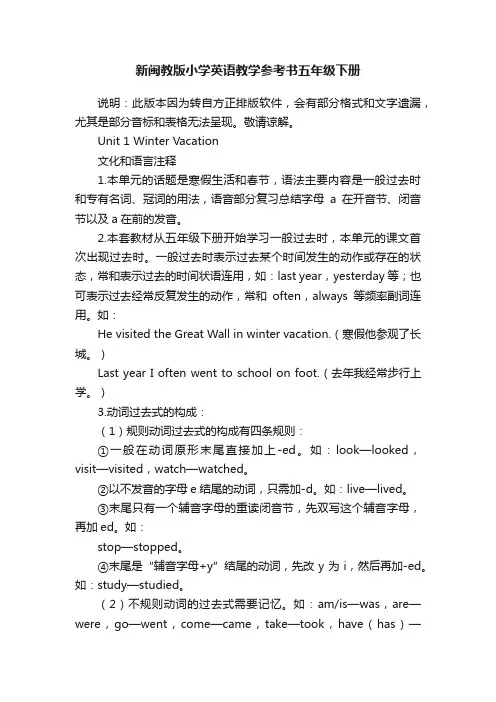
新闽教版小学英语教学参考书五年级下册说明:此版本因为转自方正排版软件,会有部分格式和文字遗漏,尤其是部分音标和表格无法呈现。
敬请谅解。
Unit 1 Winter Vacation文化和语言注释1.本单元的话题是寒假生活和春节,语法主要内容是一般过去时和专有名词、冠词的用法,语音部分复习总结字母a在开音节、闭音节以及a在前的发音。
2.本套教材从五年级下册开始学习一般过去时,本单元的课文首次出现过去时。
一般过去时表示过去某个时间发生的动作或存在的状态,常和表示过去的时间状语连用,如:last year,yesterday等;也可表示过去经常反复发生的动作,常和often,always等频率副词连用。
如:He visited the Great Wall in winter vacation.(寒假他参观了长城。
)Last year I often went to school on foot.(去年我经常步行上学。
)3.动词过去式的构成:(1)规则动词过去式的构成有四条规则:①一般在动词原形末尾直接加上-ed。
如:look—looked,visit—visited,watch—watched。
②以不发音的字母e结尾的动词,只需加-d。
如:live—lived。
③末尾只有一个辅音字母的重读闭音节,先双写这个辅音字母,再加ed。
如:stop—stopped。
④末尾是“辅音字母+y”结尾的动词,先改y为i,然后再加-ed。
如:study—studied。
(2)不规则动词的过去式需要记忆。
如:am/is—was,are—were,go—went,come—came,take—took,have(has)—had等。
4. —How was your winter vacation?(你的寒假过得如何?)—It was wonderful. I visited the Great Wall.(好极了,我参观了长城。
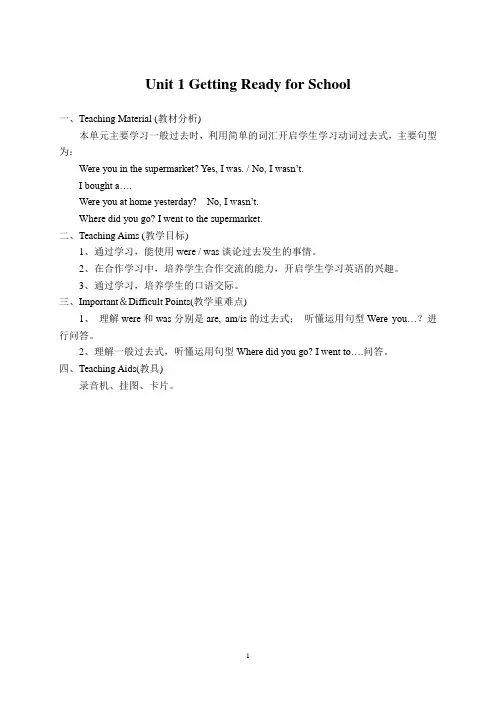
Unit 1 Getting Ready for School一、Teaching Material (教材分析)本单元主要学习一般过去时,利用简单的词汇开启学生学习动词过去式,主要句型为:Were you in the supermarket? Yes, I was. / No, I wasn‘t.I bought a….Were you at home yesterday? No, I wasn‘t.Where did you go? I went to the supermarket.二、Teaching Aims (教学目标)1、通过学习,能使用were / was谈论过去发生的事情。
2、在合作学习中,培养学生合作交流的能力,开启学生学习英语的兴趣。
3、通过学习,培养学生的口语交际。
三、Important&Difficult Points(教学重难点)1、理解were和was分别是are, am/is的过去式;听懂运用句型Were you…?进行问答。
2、理解一般过去式,听懂运用句型Where did you go? I went to….问答。
四、Teaching Aids(教具)录音机、挂图、卡片。
Unit 1 Getting Ready for SchoolLesson 1一、教学目标1、知识目标:(1)Were you in the supermarket? Yes, I was. / No, I wasn‘t.(2)I bought a….(3)were, was, just now, bought, schoolbag, bookstore.2、能力目标:能使用were / was谈论过去发生的事情。
二、重点、难点1、理解were和was分别是are, am/is的过去式;2、听懂运用句型Were you…?进行问答。
三、资源准备Tape recorder,cards,some cards.四、教学过程Ⅰ.Warmer1.Greetings.2. Free talk.Ⅱ.Presentation:1. Show the word cards and review some words.pen, pencil, book, bag, school…2. Teac h and practice ―schoolbag‖(read it one by one)school+bag→schoolbag3. T: Take your schoolbags, getting ready for school. Today w e‘ll learn Unit 1 Getting Ready for School Lesson 1.(Write down the title.)Ⅲ.New lesson1. T: I want to buy a new bag. Where can I go?S: Supermarket.2. I‘m in the supermarket now.3. book → bookstore in the bookstoreHe / She is in the bookstore.4. now → just nowExplain it is the past time.5. Explain and practice these verbs and the past tense.am / is → was are → were buy → bought6. Change the sentences. PPT shows some places and things , ask the Ss to practice the sentences.I was in the … just now.I bought a ….7. Teach and practice ―Were you in the …? Yes, I was./ No, I wasn‘t.‖(1)Practice the sentences in groups.(2) Ask and answer.8. Learn to say.(1) Listen and point.(2) Listen and repeat.(3) Read in roles..Ⅳ.Practice:1. Look and say.2. Work in pairs.Were you in the …? Yes, I was.3. Play a guessing game.4. Let‘s chant.Ⅴ.Homework:1. Read the text.2. Copy the new words and make sentences.3. Finish Activity Book Lesson 1.Unit 1 Getting Ready for SchoolLesson 2一、教学目标1、知识目标:(1) Were you at home yesterday? No, I wasn‘t.(2)Where did you go? I went to the supermarket.(3)Words: yesterday, did, went.2、能力目标:谈论过去发生的事情。
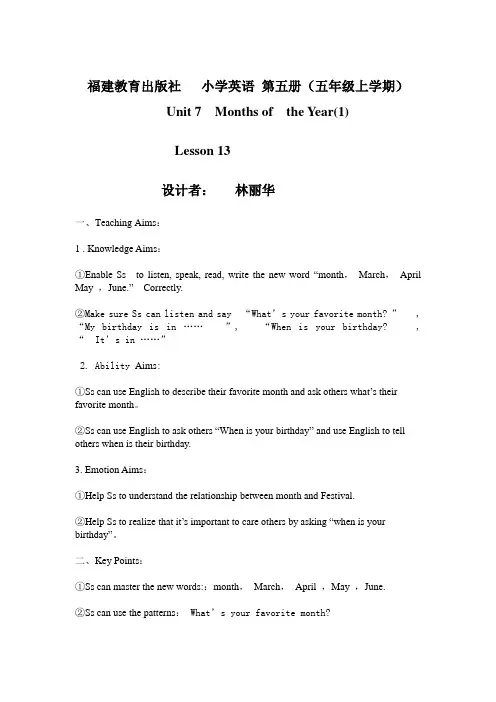
福建教育出版社小学英语第五册(五年级上学期)Unit 7 Months of the Year(1)Lesson 13设计者:林丽华一、Teaching Aims:1 . Knowledge Aims:①Enable Ss to listen, speak, read, write the new word “month,March,April May ,June.”Correctly.②Make sure Ss can listen and say “What’s your favorite month?” , “My birthday is in …… ”, “When is your birthday? , “It’s in ……”2. Ability Aims:①Ss can use English to describe their favorite month and ask others what‟s theirfavorite month。
②Ss can use English to ask others “When is your birthday” and use English to tell others when is their birthday.3. Emotion Aims:①Help Ss to understand the relationship between month and Festival.②Help Ss to realize that it‟s important to care others by asking “when is your birthday”。
二、Key Points:①Ss can master the new words::month,March,April ,May ,June.②Ss can use the patterns:What’s your favorite month?My birthday is in …… When is your birthday?It’s in ……三、Teaching Difficulties:①the pronunciation of month [mʌnθ]and April[‘eɪ prəl]②Ss can use the patters their learned to chat with others。
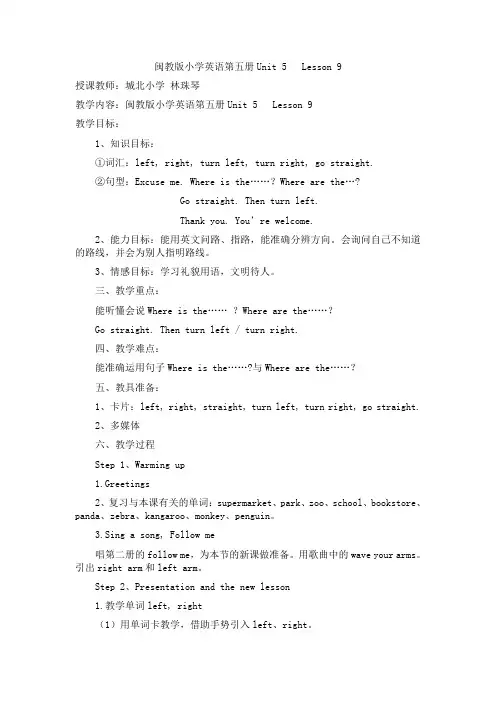
闽教版小学英语第五册Unit 5 Lesson 9授课教师:城北小学林珠琴教学内容:闽教版小学英语第五册Unit 5 Lesson 9教学目标:1、知识目标:①词汇:left, right, turn left, turn right, go straight.②句型:Excuse me. Where is the……?Where are the…?Go straight. Then turn left.Thank you. You’re welco me.2、能力目标:能用英文问路、指路,能准确分辨方向。
会询问自己不知道的路线,并会为别人指明路线。
3、情感目标:学习礼貌用语,文明待人。
三、教学重点:能听懂会说Where is the…… ?Where are the……?Go straight. Then turn left / turn right.四、教学难点:能准确运用句子Where is the……?与Where are the……?五、教具准备:1、卡片:left, right, straight, turn left, turn right, go straight.2、多媒体六、教学过程Step 1、Warming up1.Greetings2、复习与本课有关的单词:supermarket、park、zoo、school、bookstore、panda、zebra、kangaroo、monkey、penguin。
3.Sing a song, Follow me唱第二册的follow me,为本节的新课做准备。
用歌曲中的wave your arms。
引出right arm和left arm。
Step 2、Presentation and the new lesson1.教学单词left, right(1)用单词卡教学,借助手势引入left、right。
T: Show me your hands, now, wave your right hands, then, wave your left hands(2)师呈现教学卡片,左手拿left , 右手拿right,让学生自己试着拼读。
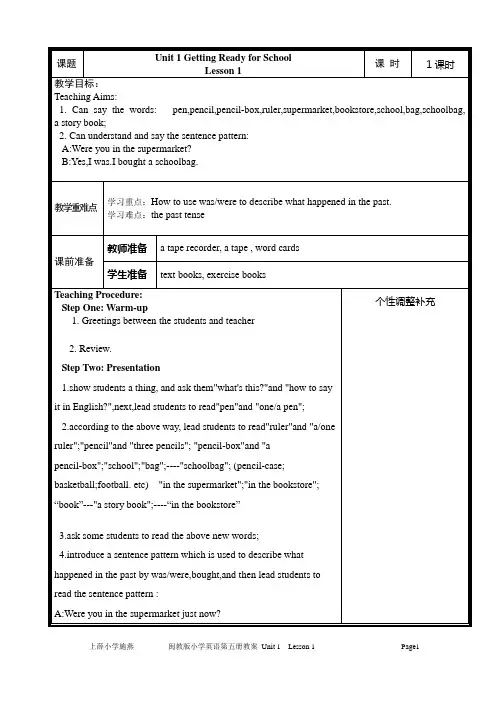

Unit 4 A Spring Outing文化和语言注释1.本单元的话题是学校的春游活动,继续学习巩固be going to 表示计划、准备做某事的句型。
Part A部分用该句型谈论春游活动的准备工作,Part B部分的课文用现在进行时描述春游的场面,在看图说英语栏目将be going to 和现在进行时进行比较,在阅读栏目用一般过去时讲述已经过去的春游活动,本单元学习和复习三种时态。
语音部分总结读作\[e\]的字母组合ea以及e在闭音节中的读音。
2. We are going for a spring outing.(我们将要去春游。
)这一句也可以说成We are going to go for a spring outing.又如:They are going to Beijing.(他们准备去北京。
)和They are going to go to Beijing.是同一个意思。
be going to 后面接的动词如果是go可以采用更简洁的表达法。
如:We are going shopping this afternoon.(今天下午我们打算去购物。
)3. We’re going to c limb a mountain.(我们打算去爬一座山。
)(1)mountain的意思是“山、山岳”,其复数形式mountains 常表示“山脉”,通常指比hill 大或陡峭的高山。
例如:the Rocky Mountains (洛矶山脉)。
(2)hill 的意思是“小山”,通常指比mountain 小的山。
如:The house stands on the top of the hill.(房子位于山顶上。
)4.—What’re you going to take with you? (你准备带什么去?)—I’m going to take some water with me.(我打算带点水去。
)take…with sb是“随身带着”的意思。
Unit 5 Asking the Way(1)Lesson 9教学设计漳州市实小古雷分校黄素梅一、说教材1、教学内容和学情分析本节课学习闽教版英语第五册第五单元。
第五单元的话题是Asking the Way (问路),这是孩子们熟悉和喜欢的生活题材。
从第九课到第十二课都是这个话题,Lesson9是第一次接触到问路话题。
课文有四部分,先通过书中的主人翁woman 和man的对话,来呈现如何问路和三种指路的表达方式,接着是Let‟s act.以听口令做动作的活动方式学习三种指路方式,第三部分是图文并茂的Ask and answer运用环节,最后是Sing a song。
通过本课学习,学生初步懂得如何有礼貌地问路和指路,是后面几课学习的基础。
根据课文内容和小学生好奇、求趣、求新的年龄特点,本人在教学活动中重新整合教材,使活动有密度与梯度,又有趣味性。
先把唱歌当作热身,把Let‟s act活动部分提到读对话之前进行重点训练,接着学习朗读对话,学会如何问路和三种指路的表达方式,最后图文并茂的Ask and answer运用语言,完成任务。
2、教学目标(三维目标)(1)认知目标能听、说、读、写以下单词和词组:left, right, turn left, turn right, go straight.能听懂、会说、会读句子:①Excuse me. Where is the……?Where are the…?②Go straight. Turn left. Turn right.③Thank you. You‟re welcome.(2)能力目标①能初步运用英文问路、指路,能准确分辨方向。
②通过本节课学习,进一步培养听、说、读、演的能力和初步的书写能力。
(3)情感策略目标①通过活动、游戏等,激发学生学习英语的兴趣,培养他们敢于、乐于、善于开口讲英语,并能积极参与交流。
②通过课文中“Excuse me. Thank you. You‟re welcome.”等礼貌用语学习,让学生学会礼貌用语,文明待人;懂得为人指路,乐于助人。
3、T:There are many animals at the zoo. Today we are going to know about two new friends .One is kangaroo .The other is penguin .( teaching : kangaroo penguin ) (raising tone or fall tone )T: Panda /kangaroo/penguin is coming .Can you tell me panda/kangaroo/penguin is from (China /Australia /the South Pole ).(teaching: the South Pole)Then teach students Panda /Kangaroo /Penguin's favorite food is ( grass / fish )。
4、Show different pictures of the animals, then ask students to say :Where are you from? What’s your favorite food----Where are you from ?----I'm from------.----What's your favorite food ?Can drill in pairs.5、Learning part 1 Learn to say .On page 21 , Play the tape . Listen point and read. Play the tape again. Read after the tape .Read together .The girls ask ,the boys answer .(change)Step Three: Consolidation1、Play the tape. Read after the tape. Then ask some pairs to work it out. Part 2 play a game.2、Part 3 Look and write.1) Look at the picture and say it .Then write .2) Ask some students to say it . Then correct .3、Read and answer on page 24Step Four: Homework1.Write and recite new words.2. Finish the exercise book of Lesson5.3.Recite Part 1.-温馨提示:如不慎侵犯了您的权益,可联系文库删除处理,感谢您的关注!。
Unit 1Meeting New Friends英语教学参考书Unit 1Meeting New Friends文化和语言注释1.本单元的主要话题是“结识新朋友”,功能为询问人物身份,描述人物的特征。
主要语法内容是:以which 开头的特殊疑问句;that用作形容词和指示代词;介词beside,behind,with的用法;ch和tch的读音规则。
本套教材从五年级上册开始每单元只有Part A教学语音,在Part B部分则增加了阅读回答问题栏目。
2.—Who s that boy?(那个男孩是谁?)—Which boy?(哪个男孩?)—The tall boy beside Wang Tao.(王涛旁边的那个高个子男孩。
)—That s Peter.He s a new pupil.(那是彼得,一位新来的学生。
)(1)“that”在英文中是一个使用频率很高的单词,有多种词性。
本课中that指离说话人较远的人物。
在Who s that boy?(那个男孩是谁?)这个句子中,that作形容词,后接单数名词,而后接复数名词时则要用those。
例如:Look at that monkey.(看那只猴子。
)Look at those monkeys.(看那些猴子。
)在That s Peter.这一句中that作代词用,指代前面说过的“that boy”。
(2)Which boy?(哪个男孩?)which在句子中作疑问形容词,后接名词。
类似的用法在本套教材四年级上册的第2单元学过:Which class are you in?(你在哪个班级?)又例如:Which book do you like?(你喜欢哪一本书?)which 也可以作疑问代词,如:Which is your classroom?(哪一间是你们的教室?)(3)The tall boy beside Wang Tao.(王涛旁边的那个高个子男孩。
)beside是介词,意思是“在……旁边”、“在……附近”。
如:The girl is sitting beside her mother.(女孩坐在她母亲的旁边。
)There is a tree beside the house.(房子的附近有一棵树。
)在句子The tall boy beside Wang Tao.中,beside Wang Tao作定语用,修饰boy,解释为“王涛旁边的”。
英语后置的定语形式和汉语的定语形式差别较大,学生在理解掌握方面有一定困难,教师要多举例说明。
本单元第3页的Ask and answer.栏目提供了部分例句和练习,以下几个例子供参考:the boy with blue eyes (蓝眼睛的男孩)the girl with a red umbrella (拿着一把红雨伞的女孩)the boy in a black car (黑色小轿车里的男孩)the baby in pink (穿粉红色衣服的婴儿)(4)pupil的意思是“小学生”,也指画家、音乐家等的“弟子”。
3.He s very good at sports.(他体育运动方面非常好。
)be good at…意思是“擅长……”,由于at是介词,在其后要用名词、代词的宾格或动名词。
如:Lily is good at math and English.But I m not good at them.(李丽数学和英语都很好,但是我这两门功课都不好。
)Julia is very good at playing the violin.(朱莉娅小提琴拉得很好。
)4.字母组合ch,tch 可以读作/t/,除了本单元第3页的例词外,学过的含有ch,tch的单词还有:teacher,which,children,chicken等。
字母组合ch的另一种读音是/k/,如:Christmas,school。
5.本单元的B部分继续学习和巩固A部分所学的主要句型。
B部分学到单词hair,教师可以借此机会帮助学生复习表示人体各部位的单词。
6.The girl with short hair.(短头发的那个女孩。
)这一句中的with short hair也是介词短语作定语,修饰the girl。
short 解释为“短的”时,其反义词是long (长的);当short 意思为“矮的”时,其反义词是tall(高的)。
7.He is from Australia.(他来自澳大利亚。
)澳大利亚(Australia)不仅国土辽阔,而且物产丰富,是南半球经济最发达的国家,全球第十二大经济住的地方。
1901年,殖民统治结束,澳大利亚成为一个独立的联邦。
澳大利亚人口高度都市化,近一半国民居住在悉尼和墨尔本这两大城市。
澳大利亚是一个体育强国,常年举办多项全球体育盛事,是每年的一级方程式赛车和澳大利亚网球公开赛的常年主办国,曾两次主办夏季奥运会。
e and play basketball with us.(来和我们一起打篮球吧。
)with是介词,在其后要使用名词、代词的宾格或动名词。
如:Tom is my brother.I often play football with him.(汤姆是我哥哥/弟弟,我常和他一起踢足球。
)9.But I like to watch you play.(但是我喜欢看你们打篮球。
)注意watch you play中跟在宾语之后的动词要用原形,即使宾语是第三人称单数形式,接在其后的动词仍要用原形。
如:I often watch my sister dance.(我经常观看我姐姐/妹妹跳舞。
)PartA教学目标◆语言知识目标1.学习单词tall,pupil,Australia,能够初步运用beside,behind,on等表示方位的介词。
2.学习句型:Who s that boy?Which boy?The boy beside/behind/with….He s a new pupil.3.学习字母组合ch和tch在单词中的发音。
4.学说韵律诗:Who s the Girl?5.学唱歌曲:Do You Know the Tall Boy?6.功能:能用英语描述他人。
◆语言技能目标1.能用英语描述他人所处的方位。
2.能用英语介绍他人的一些简单信息。
◆情感态度通过学习谚语A friend in need is a friend indeed.(患难见真情。
)告诉学生要善于交友,团结友爱。
◆文化意识了解澳大利亚的概况。
教具准备1.单词卡片:(1)单词卡片:ball,wall和tall等。
(2)词组卡片:play basketball,play the violin等。
(3)一些班牌卡片。
(4)新词beside,behind和Australia的卡片。
2.澳大利亚的国旗、伦敦大本钟、北京天安门、上海东方明珠、台湾阿里山等图片。
3.Peter的头像一张,玩具娃娃一个,本班学生集体照一张。
4.录音机或教学光盘。
教学过程Step 1 Warming up1.师生互致问候。
2.师生自由对话,如:××× is our new friend.Hello,×××! Nice to meet you.Where are you from?Which class are you in?3.欣赏歌曲:Do You Know the Tall Boy?4.教师指着歌曲的题目说:“Do you know the tall boy?”边说边出示单词卡片ball,wall,tall,帮助学生学习新词tall的音、形、义,然后告诉学生:“He is our new friend,Peter.Today let s talk about Meeting New Friends.”揭示并板书课题:Unit 1 Meeting New FriendsPart A。
Step 2 Review1.复习词组:play basketball,play the violin,play football,ride a bike等。
(1)教师出示词组卡片,学生边认读边做相应的动作。
(2)游戏——我做你说。
游戏规则:每组请一位学生上台,面向全体学生站好,教师出示词组卡片,台下的学生发指令,台上的学生快速做出相应的动作,做得又快又好的学生所在的小组获得加分。
2.复习句型:Who s that boy/girl?Which class are you in?(1)教师出示班上个别学生的照片,将学生的脸部遮住,然后问:“Who s that boy/girl?”学生用That s….来猜,猜对后,请该学生起立,教师问:“Which class are you in?”学生根据实际回答。
(2)教师出示“三年(3)班”、“六年(5)班”等班牌卡片,请学生说一说,写一写。
Step 3 Presentation(一)初步感知课文内容。
1.教师说:“You are in Grade Five now.In your English book you will meet a new friend.His name is Peter.He isa new pupil.He s from Australia.He can play football.He s very good at sports.”2.教师在黑板上或电脑上出示下列句子:His name is .He s a new .He s from .He can .He s very good at .3.教师播放课文录音或教学光盘,学生边看边从对话中找出答案。
4.请个别学生带着书上台,将黑板上的五个句子补充完整。
5.教学单词pupil和Australia。
(1)教师出示Peter的头像,一边贴在黑板上的五个句子的旁边,一边说:“His name is Peter.He s a new pupil.”出示单词卡片pupil,教学单词pupil。
告诉学生pupil与student的区别。
教师让学生用单词pupil 说句子,如:I m a pupil.He is a pupil.She is a pupil.We are pupils.Peter is a new pupil.等。
(2)教师指着Peter的头像接着问:“Where is Peter from?”引导学生看第三个句子:He s from Australia.出示单词卡片Australia,教学单词Australia。
告诉学生地名的首字母要大写。
复习Beijing,Taiwan和London 的音和形。